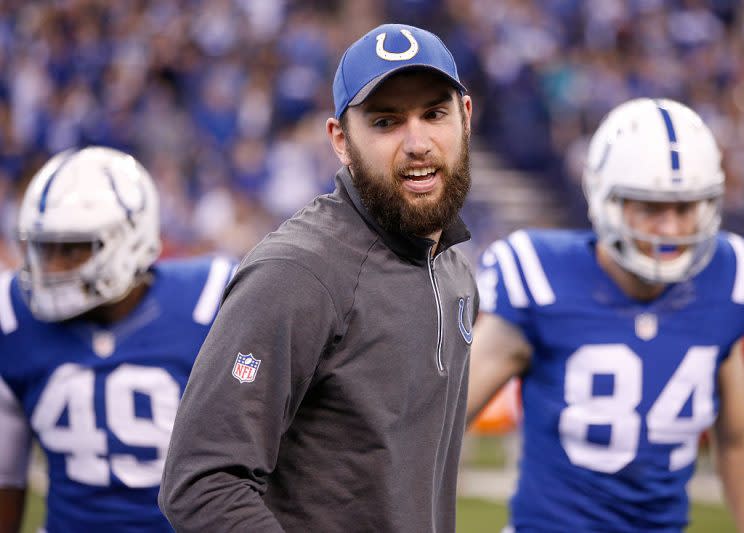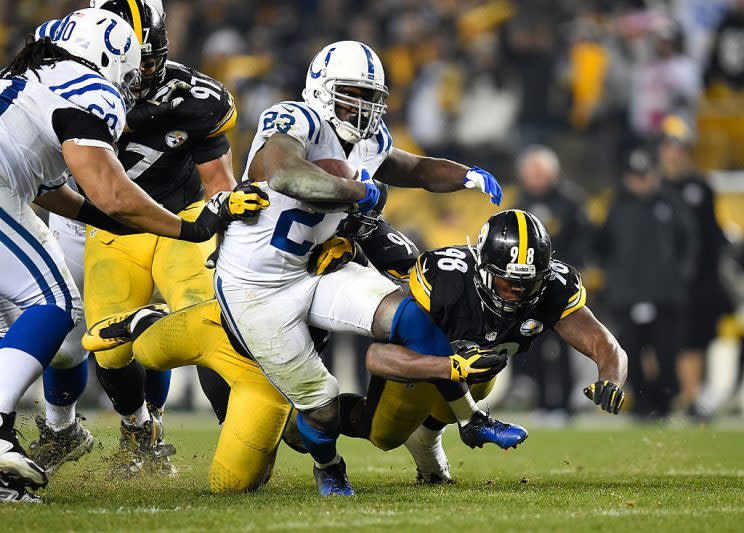Juggernaut Index, No. 14: The Indianapolis Colts

The Juggernaut Index is our annual ranking and review of NFL teams for fantasy purposes — repeat: FANTASY PURPOSES. Here we concern ourselves with a franchise’s likely contributions to the fantasy player pool. We are not concerned with projected wins and losses. Instead, we’re focused on yards and points. As always, we’re beginning with the league’s least useful teams, working our way toward the elite fantasy juggernauts.
[Join a Yahoo Fantasy Football league for free and make 2016 your season!]
Entering 2015, we all expected big things from the Indianapolis Colts. Instead, this team delivered hilarious personnel decisions, hideous injuries, endless turnovers, and the single worst decision in the history of football organized human activity.
It’s tempting to regard the Colts’ struggles last year as the unavoidable result of Andrew Luck’s injury-marred season, but we should note that the team won only two of the seven games he started. Luck was simply a massive disappointment. He completed just 55.3 percent of his throws, averaging a miserable 6.4 yards per attempt, and he tossed nearly as many interceptions (12) as touchdown passes (15). It certainly didn’t help that he was playing through pain, but that’s hardly uncommon in the NFL.
Of course Luck is just a year removed from a 4700-yard, 40-touchdown season and his career highlight reel is of the highest quality, loaded with wow throws. All of the things we liked about his fantasy set-up last year remain in place. His receiving corps is excellent, the team’s running game is substandard, and Indy’s defense isn’t anything special. If the Colts are going to return to the postseason, Luck will need to drag ’em there, orchestrating a few 38-31 wins. He isn’t going to lead the league in passer-rating or completion percentage, but he’s a decent bet to rank top-three in yards and touchdowns — and for fantasy purposes, that’s really all we need. Luck’s draft-day price was absolutely insane last year, but he’s appropriately valued in 2016 (ADP 48.1, QB3).
If you’re forecasting anything close to a 4500-35 season for Luck, then it’s easy to see a path for both T.Y. Hilton and Donte Moncrief to finish as top-20 wideouts. This is simply a terrific receiving tandem. Hilton has already produced three straight 1000-yard campaigns, and Moncrief is an obvious breakout candidate entering his third year as a pro. Early drafters are paying an expectant price for Moncrief, no question (ADP 55.5, WR27), but he’s a size/speed combo player tied to a high-volume passing attack. In the seven games started by Luck last season, Moncrief averaged 7.7 targets and caught five TD passes.

Phillip Dorsett will see plenty of snaps this season, as the Colts won’t be lining up in two-TE formations as often as they have in recent years. Dorsett is a burner with 4.3-speed and big-play ability, but, realistically, he’s the third or fourth man in this team’s receiving hierarchy. If you can draft him as a late flier, great.
Dwayne Allen is set up for a career year at tight end, if he can manage to stay healthy (which isn’t a lock). Coby Fleener has relocated to New Orleans, leaving 80-90 targets up for grabs. Allen won’t get ’em all, but he’ll take a slice. He’s never going to remind anyone of a vintage Jimmy Graham, but he’s a proven red-zone threat with a clear shot to produce, say, a 60-650-8 fantasy line. Again, there should be plenty of receiving stats for every starting skill player in this offense.
Indy’s running game was mostly useless last season, ranking No. 29 in the league while averaging less than 90 yards per week. Frank Gore retains the feature role in this backfield at age 33, but he’s coming off a year in which he averaged a career-low 3.7 yards per carry. Not good. Generally speaking, we don’t expect bounce-back seasons from ancient running backs. Still, Gore closed his 2015 campaign with a pair of respectable games (34-161-2), and he’ll serve as the lead back for a high-yield offense. He may never again crack 4.0 YPC, but he nonetheless has the potential to deliver another serviceable fantasy season. At his current ADP (66.4, RB29), he’s completely tolerable. Gore actually ranked as the No. 11 RB in standard leagues last year, but that’s more of an indictment of the position than an argument for the player.

Undrafted Illinois rookie Josh Ferguson generated modest training camp buzz, and, considering the unimpressive state of this team’s backfield depth, he could have a rotational/third-down role in 2016. He’s a proven receiver, but this is not a guy who piles up tough yards between the tackles. Ferguson is a nice enough PPR dynasty flier. Let’s leave it at that. If Gore were to miss time, Ferguson would likely share touches with Robert Turbin. There’s no must-draft handcuff here. (Note: Brad feels differently, but he abandons reason and self-control when Illini running backs are up for discussion.)
Indy’s defense is a middle-of-the-pack group that doesn’t belong on anyone’s cheat sheet. IDP players are no doubt familiar with LB D’Qwell Jackson, a high-volume tackler, but this team D/ST is strictly a streaming option for desperate owners. The AFC South isn’t a total wasteland these days, so you won’t find many appealing matchups for this D.
—
2015 Offensive Stats & Ranks
Points per game – 20.8 (24)
Pass YPG – 231.5 (22)
Rush YPG – 89.9 (29)
Yards per play – 4.9 (31)
Plays per game – 65.8 (11)
—
Previous Juggernaut Index entries: 32) Cleveland, 31) San Francisco, 30) Philadelphia, 29) Baltimore, 28) Tennessee, 27) Los Angeles, 26) Miami, 25) Detroit, 24) Chicago, 23) San Diego, 22) Minnesota, 21) Tampa Bay, 20) Atlanta, 19) Washington, 18) Buffalo, 17) Kansas City, 16) Oakland, 15) NY Giants, 14) Indianapolis



